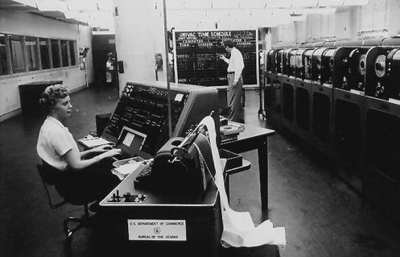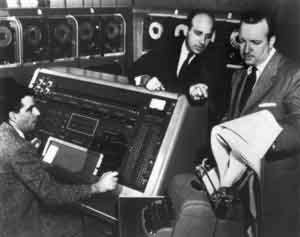| Eckert & Mauchly and ENIAC |
| Written by Historian | ||||||
Page 2 of 2
ENIAC - the first computer?ENIAC was started in 1943 and completed at the end of 1945 - and so missed the war by a few months. It was huge. It used just short of 18000 vacuum tubes arranged in racks 100 feet long in total. It consumed enough electricity, about 150kW, for a small town and disposing of the heat produced by the vacuum tubes was no small problem. But it worked. It could add two numbers in 0.2 milliseconds and this speed increase made calculations possible would have simply taken too long by other methods available at the time. In today's terms ENIAC's arithmetic performance is equivalent to an IBM PC running at .005MHz - which is a lot better than the relay computers could manage. It even managed to work for reasonable periods of time between vacuum tube failures, up to 20 hours. ENIAC was used for 10 years and did a huge amount of computation in that time. It not only computed trajectories but ran the simulations needed for the H bomb. It also caught the public imagination. In a public demonstration it added numbers and plotted shell trajectories in real time. It took only twenty seconds to work out the trajectory of a shell that took 30 seconds to reach its target. ENIAC's flashing lights and switch banks also set the look of machines in film and fiction that has hardly changed through to the present day!
Betty Jean Jennings (left) and Fran Bilas (right), two of ENIAC's six female programmers, operate its main control panel.
ENIAC differed in a number of important ways from a modern computer. The first is, that despite the work of Shannon and others, ENIAC used the decimal system to do arithmetic. It worked with ten digit signed arithmetic. The arithmetic units also mimicked the way that mechanical calculators worked using gear wheels. A ring counter can be considered to be the electronic equivalent of a rotating gear wheel in the sense that it has ten states only one of which is active. An input pulse makes the state change to the next and when the last state is reached a pulse is output and the ring moves back to the first state. The output is used as a carry to the next position of the number and addition is performed by feeding in the correct number of pulses. So adding two numbers together really did simulate the rotation of gear wheels counting the number of times the calculating machine's handle is turned. This is a long way from the way a modern computer uses Boolean logic to perform addition. It also didn't have the internal structure of a modern computer and was more like a collection of logic circuits that could be connected in different ways. It had to be programmed using plug board and wires that looked like a small telephone exchange. It could take days to "program" the machine to solve a problem that would take only a few minutes to run. It wasn't a stored program machine but it did have loops and conditionals but the programs were created using wire connections and setting switches. This was the way that existing and very sucessful analog computers were organized. They had units that performed mathematical functions such as addition, multiplication, integration and so on and these were writed up together to provide a simulation of a mathematical equation. ENIAC wasn't so different just digital. The First?So was ENIAC the first electronic digital computer? You can now see that the question is a difficult one as it all depends what you mean by digital computer. The serious challengers for the title are the Colossus - a secret code breaking computer built in the UK, Konrad Zuse's relay/electronic machines built in Germany and the Atanasoff-Berry Computer. Each of these had differences from modern machines - the Colossus was programmed using hardware and not general purpose. The ABC used binary was programmed using hardware and only solved linear equations. Zuse's Z3 machine looked more like a modern computer than the other two but lacked conditional branching. If you restrict the definition of computer to stored program computer then the Manchester "Baby" is probably the best candidated for the first.
The biggest problem in constructing a stored program computer was how to achieve the large amount of memory needed to store the program and the data.
Using vacuum tubes was prohibitively expensive. Eckert suggested using mercury delay lines of the type used to store radar pulses and this indeed proved possible. However, EDVAC, his next computer, wasn't the first stored program computer to be put into operation. Manchester University built and operated a prototype in 1948 and EDSAC at the University of Cambridge was completed in 1949 but EDVAC wasn't completed until 1952.
After ENIAC
After ENIAC came EDVAC, a true stored program computer. Instead of having to be programmed using plug boards and wires, EDVAC stored its instructions along with its data in the manner of all computers since. The idea for a stored program computer is attributed to Von Neumann as a consequence of his accidental meeting with Goldstine on a railway platform. However no idea is completely new and it is possible that Presper Eckert had a hand in it. The strange twist to this story is that Mauchly and Eckert left the EDVAC project before it was completed. The reason was that the University of Pennsylvania insisted that all inventions patents etc. created by people working for it were the property of the University. Mauchly and Eckert refused to sign the release giving the University the rights to the technology that they had created. As a result they left, the Moore School lost the lead in computing and the first computer company - The Electronic Control Company - came into existence. This may not seem like of a gamble, but leaving secure university jobs to start an industry which some experts had said would have a market of only six machines in the whole of the USA was very risky. They failed to find backers and Eckert's father put up the $25000 needed - and so once again set the tone for future startups! They tried to find a buyer for their planned machine and for the second time in the history of computing the US Census Bureau fitted the bill. The first time it was Hollerith's punch cards and associated equipment but for the imminent 1950 census punched cards looked distinctly impractical. Keen to use electronics they placed the first commercial order for a computer - Mauchly and Eckert's UNIVersal Automated Computer, i.e. UNIVAC - in 1946 for $350,270.
UNIVAC at the US Census Bureau
Work began in 1946 but neither Mauchly or Eckert were reasonable managers and they quickly fell behind schedule and ran into debt. Even so they managed to find a total of four buyers for their machine and pioneered new revolutionary techniques such as digital tape drives for data storage. But lack of funds remained their main problem. In 1950 the re-named Eckert-Mauchly Computer Company was taken over by Remington Rand - yes, the people who made razors and assorted office equipment! Remington paid $200,000 to Eckert and Mauchly and guaranteed their employment for eight years. In 1951 the first Univac was delivered, late and over budget. Univac was the first commercial computer in the US (LEO 1 was produced commercially in the UK in the same year) and, proving the pessimists wrong, various companies immediately ordered a total of 50.
J. Presper Eckert and CBS anchor Walter Cronkite discuss the UNIVAC 1952 US Presidential Election prediction
UNIVAC became an overnight TV star when it correctly predicted the outcome of the US presidential elections again proving the pundits wrong. The headlines the next day read "Machine Makes Monkey Out of Man" and the modern era of computing was well and truly started. Remmington Rand, and more or less everyone else, eventually lost the lead to a late starter in the computer field - IBM - but that's another story.
Related ArticlesKonrad Zuse And The First Working Computer John Von Neumann The Great Polymath On This Day in 1946 - Eniac Unveiled Pioneering ENIAC programmer dies, aged 86 On this Day in 1919 - Presper Eckert born On this day in 1907 ... ENIAC designer born UNIVAC Predicts US Election - On This Day 60 Years Ago
To be informed about new articles on I Programmer, install the I Programmer Toolbar, subscribe to the RSS feed, follow us on, Twitter, Facebook, Google+ or Linkedin, or sign up for our weekly newsletter.
Comments
or email your comment to: comments@i-programmer.info |
||||||
| Last Updated ( Wednesday, 03 December 2014 ) |





